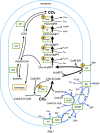Methanotrophic archaea possessing diverging methane-oxidizing and electron-transporting pathways
- PMID: 24335827
- PMCID: PMC3996691
- DOI: 10.1038/ismej.2013.212
Methanotrophic archaea possessing diverging methane-oxidizing and electron-transporting pathways
Abstract
Anaerobic oxidation of methane (AOM) is a crucial process limiting the flux of methane from marine environments to the atmosphere. The process is thought to be mediated by three groups of uncultivated methane-oxidizing archaea (ANME-1, 2 and 3). Although the responsible microbes have been intensively studied for more than a decade, central mechanistic details remain unresolved. On the basis of an integrated analysis of both environmental metatranscriptome and single-aggregate genome of a highly active AOM enrichment dominated by ANME-2a, we provide evidence for a complete and functioning AOM pathway in ANME-2a. All genes required for performing the seven steps of methanogenesis from CO2 were found present and actively expressed. Meanwhile, genes for energy conservation and electron transportation including those encoding F420H2 dehydrogenase (Fpo), the cytoplasmic and membrane-associated Coenzyme B-Coenzyme M heterodisulfide (CoB-S-SCoM) reductase (HdrABC, HdrDE), cytochrome C and the Rhodobacter nitrogen fixation (Rnf) complex were identified and expressed, whereas genes encoding for hydrogenases were absent. Thus, ANME-2a is likely performing AOM through a complete reversal of methanogenesis from CO2 reduction without involvement of canonical hydrogenase. ANME-2a is demonstrated to possess versatile electron transfer pathways that would provide the organism with more flexibility in substrate utilization and capacity for rapid adjustment to fluctuating environments. This work lays the foundation for understanding the environmental niche differentiation, physiology and evolution of different ANME subgroups.
Figures


Similar articles
-
Reverse Methanogenesis and Respiration in Methanotrophic Archaea.Archaea. 2017 Jan 5;2017:1654237. doi: 10.1155/2017/1654237. eCollection 2017. Archaea. 2017. PMID: 28154498 Free PMC article. Review.
-
Spatial-Temporal Pattern of Sulfate-Dependent Anaerobic Methane Oxidation in an Intertidal Zone of the East China Sea.Appl Environ Microbiol. 2019 Mar 22;85(7):e02638-18. doi: 10.1128/AEM.02638-18. Print 2019 Apr 1. Appl Environ Microbiol. 2019. PMID: 30709818 Free PMC article.
-
Methane-Fueled Syntrophy through Extracellular Electron Transfer: Uncovering the Genomic Traits Conserved within Diverse Bacterial Partners of Anaerobic Methanotrophic Archaea.mBio. 2017 Aug 1;8(4):e00530-17. doi: 10.1128/mBio.00530-17. mBio. 2017. PMID: 28765215 Free PMC article.
-
Environmental regulation of the anaerobic oxidation of methane: a comparison of ANME-I and ANME-II communities.Environ Microbiol. 2005 Jan;7(1):98-106. doi: 10.1111/j.1462-2920.2004.00669.x. Environ Microbiol. 2005. PMID: 15643940
-
Genomic Insights into Niche Partitioning across Sediment Depth among Anaerobic Methane-Oxidizing Archaea in Global Methane Seeps.mSystems. 2023 Apr 27;8(2):e0117922. doi: 10.1128/msystems.01179-22. Epub 2023 Mar 16. mSystems. 2023. PMID: 36927099 Free PMC article. Review.
Cited by
-
Sulfate differentially stimulates but is not respired by diverse anaerobic methanotrophic archaea.ISME J. 2022 Jan;16(1):168-177. doi: 10.1038/s41396-021-01047-0. Epub 2021 Jul 20. ISME J. 2022. PMID: 34285362 Free PMC article.
-
Acetate and Acetyl-CoA Metabolism of ANME-2 Anaerobic Archaeal Methanotrophs.Appl Environ Microbiol. 2023 Jun 28;89(6):e0036723. doi: 10.1128/aem.00367-23. Epub 2023 Jun 5. Appl Environ Microbiol. 2023. PMID: 37272802 Free PMC article.
-
Controls on Interspecies Electron Transport and Size Limitation of Anaerobically Methane-Oxidizing Microbial Consortia.mBio. 2021 May 11;12(3):e03620-20. doi: 10.1128/mBio.03620-20. mBio. 2021. PMID: 33975943 Free PMC article.
-
Extracellular electron uptake by autotrophic microbes: physiological, ecological, and evolutionary implications.J Ind Microbiol Biotechnol. 2020 Oct;47(9-10):863-876. doi: 10.1007/s10295-020-02309-0. Epub 2020 Sep 15. J Ind Microbiol Biotechnol. 2020. PMID: 32930890 Review.
-
Methane oxidation by anaerobic archaea for conversion to liquid fuels.J Ind Microbiol Biotechnol. 2015 Mar;42(3):391-401. doi: 10.1007/s10295-014-1548-7. Epub 2014 Nov 27. J Ind Microbiol Biotechnol. 2015. PMID: 25427790 Review.
References
-
- Baumer S, Ide T, Jacobi C, Johann A, Gottschalk G, Deppenmeier U. The F420H2 dehydrogenase from Methanosarcina mazei is a redox-driven proton pump closely related to NADH dehydrogenases. J Biol Chem. 2000;275:17968–17973. - PubMed
-
- Boetius A, Ravenschlag K, Schubert CJ, Rickert D, Widdel F, Gieseke A, et al. A marine microbial consortium apparently mediating anaerobic oxidation of methane. Nature. 2000;407:623–626. - PubMed
-
- Bonin AS, Boone DR. The Order Methanobacteriales. Springer: New York; 2006.
Publication types
MeSH terms
Substances
LinkOut - more resources
Full Text Sources
Other Literature Sources

